Zhu Ying, Liu Mingjie, Wan Meixiang, Jiang Lei. 3D-Micro/Nanostructures of Conducting Polymers Assembled from 1D-Nanostructures and Their Controlling Wettability[J]. Progress in Chemistry, 2011, 23(5): 819-828.
Micro/nanostructured conducting polymers have received intense interest because of their high conductivity, ease of preparation, good environmental stability, and a large variety of applications in molecular wires, chemical sensors, biosensor, light-emmiting and electronic devices. Three dimensional (3D) conducting polymer microstructures assembled from one dimensional (1D) nanofibers have been required to provide multi-functionality and high performance applications in microelectronics technology. However, the design and synthesis of such novel 3D-microstructures assembled from 1D-nanostructure remain a challenge for materials science. Recently, our researches demonstrated that the cooperation effect of the micelles served as soft-template and the molecular interactions as self-assembly driving forces provides a facile and effective approach to construct conductive and supperhydrophobic functional 3D-micro/nanostructures of conducting polymers assembled from 1D-nanofibers. The trick of this approach is using low surface energy organic acids as the dopants that serve four functions of dopant, soft-template, self-assembly driving force, and deducing superhydrophobicity. Moreover, 3D-microstructures assembled from 2D-nanosheets consisted of 1D-nanofibers of conducting polymer were successfully synthesized by adjusting self-assembled driving force using the relative humidity of enviroment. Our researches also demonstrated that surface wettability of conducting polymer micro/nanostructures could be reversively controlled by means of chemical methods. In liquid/liquid/solid triphase system, the wettability and adhesion of oil droplet on the surface of the conducing polymers can be intelligently controlled by adjusting the electrochemical potentials.








